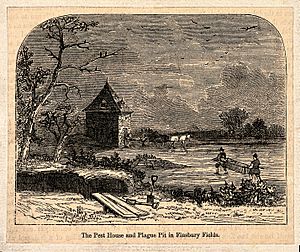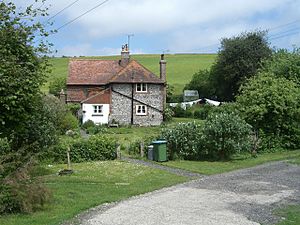Pest house facts for kids
A pest house (also known as a plague house or fever shed) was a special building used a long time ago to keep people with very contagious diseases separate from others. These diseases included illnesses like tuberculosis, cholera, smallpox, or typhus. Often, people were forced to stay in these houses as a way of quarantine (keeping sick people away from healthy ones to stop diseases from spreading). Many towns and cities had one or more pest houses, often with a cemetery or a special pond nearby for burying or disposing of the dead.
Contents
What Were Fever Sheds?
Fever sheds were temporary buildings, similar to pest houses, built quickly to handle large numbers of sick people during disease outbreaks. They were especially important when many people needed care at once.
Fever Sheds in Canada's History
In 1847, many fever sheds were built across Eastern Canada. These were used to quarantine sick and dying Irish immigrants. These immigrants had caught typhus during their long journey to the New World. This happened during the time of the Great Famine in Ireland, which caused many people to leave their homes.
Montreal's Fever Sheds
In Montreal, between 3,500 and 6,000 Irish immigrants died in fever sheds. These sheds were in a quarantine area called Windmill Point. At first, three large sheds were built, each about 45 meters (150 feet) long and 12 to 15 meters (40 to 50 feet) wide. As thousands more sick immigrants arrived, many more sheds had to be put up. The number of sheds grew to 22, and soldiers had to block off the area to make sure sick people stayed inside.
Toronto's Fever Sheds
In Toronto, during the summer of 1847, 863 Irish immigrants died from typhus. They were in fever sheds built by the Toronto Board of Health at the corner of King and John Street. There were at least 12 sheds, each about 22 meters (72 feet) long and 7.5 meters (25 feet) wide.
Saint John's Quarantine Station
Partridge Island, New Brunswick, located just outside the main harbor of Saint John, was chosen as a place for a pest house and quarantine station as early as 1785. In 1847, when many Irish migrants arrived, the typhus outbreak quickly filled the fever shed with sick and dying people. By the end of the 1847 typhus season, 2115 people had died in New Brunswick, with 1196 of them dying at Partridge Island and in Saint John.
Surviving Pest Houses Today
Some pest houses still exist today, showing us what these buildings looked like.
United States

- Pest House (Cockeysville, Maryland)
- Pest House (Concord, Massachusetts)
- Pest House (Stillwater, Minnesota)
- Pest House (Redwood City, California)
- Pest House at the Wood County Museum (Ohio)
United Kingdom
There are eight surviving pest houses in the UK, including:
- Findon, West Sussex
- Odiham
- Grantham, Lincolnshire
- Great Chart, Kent
- Cranbrook, Kent
In Deddington, Oxfordshire, there is a place called Pest House Field. Richmond, London also has a place called Pesthouse Common.
The Netherlands
There is a pest house still standing in Leiden, called the Pesthuis (nl). It was built in 1661 to hold many patients, but it was never actually used for that purpose.



